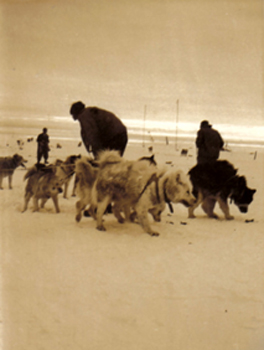In This Issue....
From
the
Editor: Good Deeds, Great and Small
Fan MailIn the News
Sledge Dog Memorial Fund Update
BAS Vignette: Sledging with Dogs
CAAT Northern Project 2008 Plans
Navigating This
Site
Index of articles by subject
Index
of back issues by volume number
Search The
Fan Hitch
Articles
to download and print
Ordering
Ken MacRury's Thesis
Our
comprehensive list of resources
Talk
to The
Fan Hitch
The Fan
Hitch home page
ISDI
home page
Editor's/Publisher's Statement
Editor: Sue Hamilton
Webmaster: Mark Hamilton
The
Fan Hitch, Journal of the Inuit Sled
Dog, is published four times a year. It is
available at no cost online at:
https://thefanhitch.org.
The Fan Hitch welcomes your letters, stories, comments and suggestions. The editorial staff reserves the right to edit submissions used for publication.
Contents of The Fan Hitch are protected by international copyright laws. No photo, drawing or text may be reproduced in any form without written consent. Webmasters please note: written consent is necessary before linking this site to yours! Please forward requests to Sue Hamilton, 55 Town Line Rd., Harwinton, Connecticut 06791, USA or mail@thefanhitch.org.
This site is dedicated to the Inuit Dog as well as related Inuit culture and traditions. It is also home to The Fan Hitch, Journal of the Inuit Sled Dog.
The Fan Hitch welcomes your letters, stories, comments and suggestions. The editorial staff reserves the right to edit submissions used for publication.
Contents of The Fan Hitch are protected by international copyright laws. No photo, drawing or text may be reproduced in any form without written consent. Webmasters please note: written consent is necessary before linking this site to yours! Please forward requests to Sue Hamilton, 55 Town Line Rd., Harwinton, Connecticut 06791, USA or mail@thefanhitch.org.
This site is dedicated to the Inuit Dog as well as related Inuit culture and traditions. It is also home to The Fan Hitch, Journal of the Inuit Sled Dog.

Halley Bay spring time, September, 1963 - 65.
photo: unknown
Sledging with Dogs
by Andrew Champness
by Andrew Champness
Seal meat is an important necessity on the base and the routine job of 'sealing' on the sea ice is undertaken as weather and larder conditions dictate. As stocks were running low and conditions fairly good, a colleague and I prepared for a trip in search of meat. Sufficient food for 10 days and camping gear were loaded on a sledge. It is general practice to take food far in excess of expected requirements because weather conditions can change quickly and a party away from base could be delayed for days.
A team of nine dogs - four pairs and "Gnat", the leader - sensed the run and were excited and difficult to hitch to the sledge. Once the team was in position we started off towards the sea ice, me riding on the back of the sledge and my partner skiing alongside. Having safely reached the sea ice we proceeded in search of seals. The dogs were running well when, for no apparent reason, first Gnat and then the remainder of the team stopped. To make sure the dogs couldn't run off while I was away from my riding position, a metal picket fastened to the sledge was made fast in the ice. We then went forward to find out why the dogs had stopped. To our surprise, just ahead of Gnat the lead dog, and impossible to see from the riding position, was a four-foot gap in the ice. We made a great fuss over Gnat and in appreciation and I let him lick my face!!
On another trip with a dog team, the doctor, a surveyor and I were staking out routes to various places when the weather changed quickly and a thick fog, known as a white-out, came down, reducing visibility to about five yards. Base was only about two miles away and although we kept moving, all sense of direction was lost. The dogs ran on but no matter what we did, the leader dog pulled to the left. Eventually we stopped the team and, having picketed the sledge, made a reconnaissance of the area. Not more than twenty feet from the sledge was the shelf-ice edge, and some distance below, the sea. Once again the leader dog had averted what might have been a fatal accident.
Andrew Champness was the base cook at Halley Bay from 1963 to 1965. He now lives in West Australia.